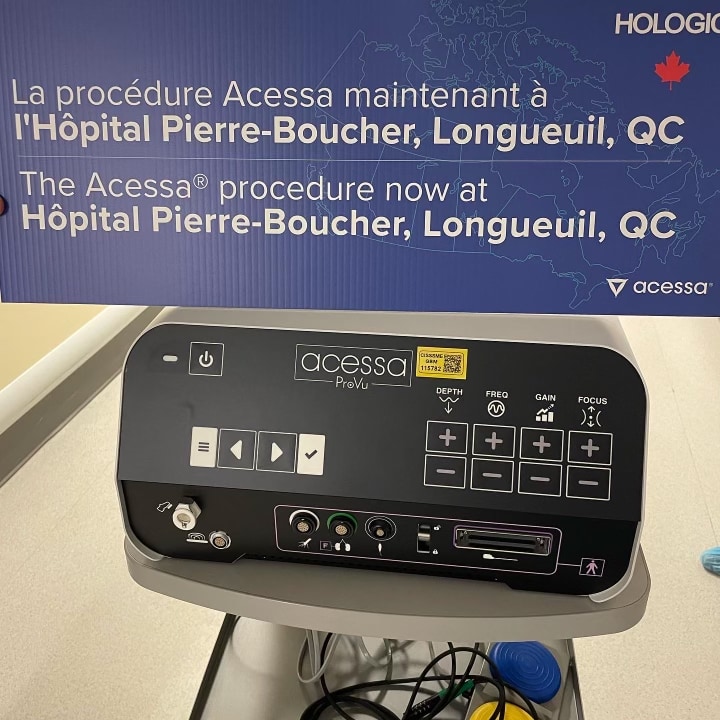HOW DOES ACESSA© WORK?
Acessa, named after the Greek god of healing Acesso, is a laparoscopic, ultrasound guided procedure that uses a small scope to look inside the abdomen and a small ultrasound transducer to image the inside of the uterus. Both the laparoscopic and ultrasound images are displayed during the procedure on two side-by-side video monitors.
A small needle probe specially designed by Dr. Bruce B. Lee, Dr. Gordon Epstein and engineers at Halt Medical is inserted through the skin and guided into each fibroid. The ultrasound image is used to locate fibroids that would otherwise not be detected by looking at the outside of the uterus.
The ultrasound image also allows the surgeon to guide the needle accurately into each fibroid. For small fibroids, only the tip of the probe is used to generate heat.
A generator supplies the energy to create the heat using electrical energy (radiofrequency ablation). The heat created in the tissue next to the needle tip conducts outward a small distance and destroys the tumor in seconds.
If the tumor is larger, an electrode array consisting of seven individual electrodes is deployed from the end of the needle probe into the fibroids essentially creating a larger needle tip. Accurate placement of the array ensures that only the fibroid will be ablated and that the normal uterine wall will be undamaged other than for the needle track.
After the ablation is complete, the electrode array is withdrawn back into the shaft of the needle probe and the needle probe is withdrawn from the fibroid and the uterine wall. Standard coagulation of the needle track stops any bleeding that might occur. A small pinhole at the surface of the uterus is the only evidence that an ablation occurred. The same process is applied to each fibroid that is present.

WHAT HAPPENS TO THE FIBROID AFTER IT IS HEATED AND DESTROYED?
The fibroid is destroyed through a process called coagulative necrosis. The fibroid cells are destroyed and can no longer grow or produce proteins that might cause symptoms. Over the next several days the entire fibroid becomes much softer, causing a relief in pressure symptoms.
The surrounding normal muscle cells gradually reabsorb the treated tissue, frequently causing complete disappearance of small and medium-sized tumors. Larger tumors can be expected to shrink in volume by about 70-80%. Eighty percent of the volume reduction that will occur after Acessa is seen by about 6 months. Over the next six months, an additional 20% shrinkage will occur.
WHO IS QUALIFIED TO PERFORM ACESSA?
Physicians who perform laparoscopic procedure and who have undergone training may be qualified to perform Acessa. The Acessa procedure requires experience as fibroids occur in all shapes, sizes, and locations.
As always, the more experienced the surgeon the better he or she can handle unexpected situations that are difficult to predict pre-operatively. In general, the more numerous and larger the fibroids the more experience is required to thoroughly and effectively ablate them.
Patients should always determine how experienced their surgeon is and how difficult their procedure might be.
FIBROID JOURNEY CASE STUDY
SA, a 44 African-American woman had been diagnosed with uterine fibroids over a decade ago. Over the years, she noticed more and more symptoms, which steadily became severe.
At first, only a few menstrual periods per year were heavier and longer. Soon, though, she had to buy 3 boxes of heavy-duty pads monthly, and had accidents, soiling her clothing. She became afraid to leave the house or go to work during her menstrual period. Fatigue set in from low blood count (anemia), making work difficult and causing her to decrease activity.
When on her menstrual period, sleep was interrupted by having to change protection multiple times per night. She also noticed that she had to urinate frequently, and soon had the urge to urinate almost constantly. Yet, when she went to void, she could only urinate small amounts. As she decreased activity, she noticed her clothing getting tighter and her abdomen getting bigger. At first she thought she was just gaining weight, though that did not make sense as she was eating only small amounts, since nausea would occur after only a few bites.
Then she realized she could feel something firm in her abdomen that kept getting bigger and bigger. She felt self-conscious about her appearance and became less social. As her abdomen grew, she noticed she could not raise her right leg nearly as well as her left. A limp developed, slowing her walk to half speed or less. She felt overwhelmed. She felt that her life and her health were out of control. Fibroids were dominating her life.
SA sought medical attention. Her physicians recommended a hysterectomy. SA however did not wish to have her uterus removed and did not wish to undergo a major surgery. She feared the complications that might occur and the long, painful recovery. So she waited, enduring her many discomforts, hoping that a better solution would become available. During this time, her uterus grew to the size of a six-month pregnancy.
SA learned about the Acessa Procedure after it was featured on The Doctors’ Show on national television. She quickly made an appointment, hoping that it was the answer to her prayers. She met Dr. Bruce Lee, the inventor of the Acessa procedure, who discussed with her the nature of uterine fibroids and all possible treatment options.
SA elected to have the Acessa Procedure. The procedure required only two small incision 5 and 10 mm in length. SA went returned home on the same day of the procedure. She experienced minimal discomfort after Acessa, and did not take any pain medication following the procedure.
Within a week after the procedure, SA could not believe her improvement. She could walk nearly normally. The nausea and urinary frequency had disappeared. She was now sleeping through the night without abdominal discomfort.
As a result, she felt more energetic and could function like she had before fibroids took control of her life. Thanks to Acessa, she was back in control. Her life was hers once
Stay Connected
Subscribe to our newsletter to receive updates on resources and guides from Dr. Bruce Lee.

 System for
System for 


